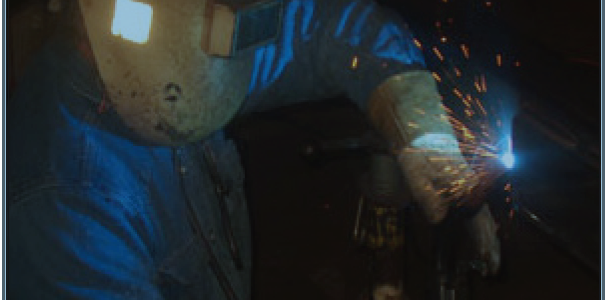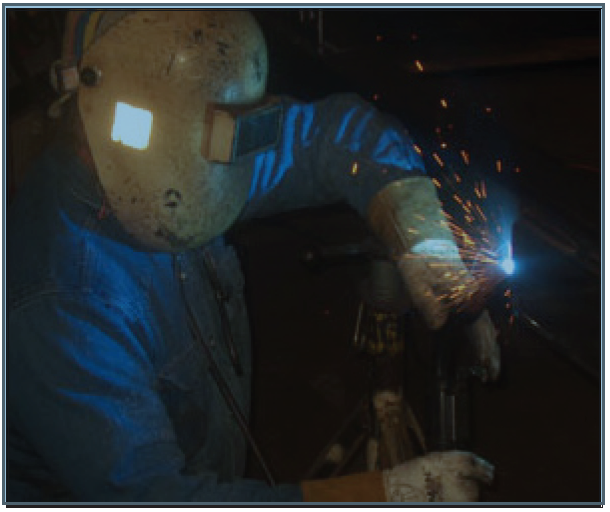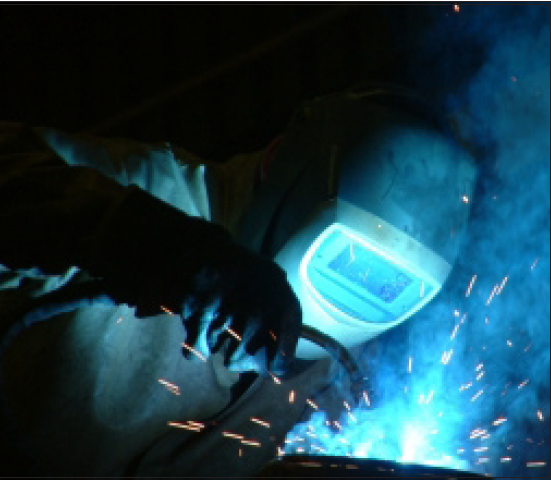
Exposure Monitoring for Hexavalent Chromium
By Jerome E. Spear, CSP, CIH

 OSHA requires employers to determine Cr(VI) exposures to employees. Options for exposure determinations include initial and periodic exposure monitoring and/or the use of objective data. If objective data is used, the data must reflect workplace conditions closely resembling the processes, types of material, control methods, work practices, and environmental conditions. If the scheduled monitoring option is used, exposure monitoring must be performed initially and periodically. For exposures that are determined to be at or above OSHA’s PEL of 5 micrograms per cubic meter (μg/m3) (8-hour TWA), exposure monitoring must be performed at least every three months. For exposures that are determined to be at or above OSHA’s Action Level of 2.5 μg/m3 (8-hour TWA), exposure monitoring must be performed every six months. Additionally, exposure monitoring must be performed whenever there is a change in work processes or materials that may result in new or additional exposures to Cr(VI). This paper describes sampling and analytical methods for Cr(VI) and considerations when conducting exposure monitoring for Cr(VI).
OSHA requires employers to determine Cr(VI) exposures to employees. Options for exposure determinations include initial and periodic exposure monitoring and/or the use of objective data. If objective data is used, the data must reflect workplace conditions closely resembling the processes, types of material, control methods, work practices, and environmental conditions. If the scheduled monitoring option is used, exposure monitoring must be performed initially and periodically. For exposures that are determined to be at or above OSHA’s PEL of 5 micrograms per cubic meter (μg/m3) (8-hour TWA), exposure monitoring must be performed at least every three months. For exposures that are determined to be at or above OSHA’s Action Level of 2.5 μg/m3 (8-hour TWA), exposure monitoring must be performed every six months. Additionally, exposure monitoring must be performed whenever there is a change in work processes or materials that may result in new or additional exposures to Cr(VI). This paper describes sampling and analytical methods for Cr(VI) and considerations when conducting exposure monitoring for Cr(VI).
Sampling and Analytical Methods
Exposure monitoring should be performed using a sampling method that is at least ±25% accurate. OSHA specifically references exposure monitoring to be performed using OSHA Method ID-215 (or equivalent). This method involves collecting an air sample onto a 5.0 micron polyvinyl chloride (PVC) membrane mounted in a 37-mm or 25-mm polystyrene cassette holder. The recommended flow rate is 2.0 liters per minute for 480 minutes (i.e., 960 liters). NIOSH Analytical Method 7605 is comparable to OSHA Method ID-215.
Cr(VI) samples collected on PVC from welding operations do not require field stabilization as with Cr(VI) samples collected from other operations (such as samples collected during chromium plating operations). However, Cr(VI) samples collected from welding operations must be analyzed within eight days of sampling in accordance with OSHA ID-215 to minimize the effects caused by the interaction of Fe(II) and Cr(VI) to form Cr(III). Storage stability tests showed that these samples were not stable for longer periods of time. Studies indicate that the loss exceeded 10% after seven days.
Significant amounts of Cr(VI) are often deposited on the interior walls of the sampling cassettes. Tests showed that Cr(VI) equivalent to 0 to 123% of the amounts found on the PVC filter were present on the interior walls of cassettes. Therefore, it is now routine analytical procedure for the lab analyst to the wipe interior walls of sampling cassettes for all metal samples.
Sampling Inside vs. Outside the Hood
OSHA ID-215 does not address the sample location or position other than the cassette should be in a vertical position with the inlet facing down. Breathing zone sampling location during welding fume exposure assessments has been a subject of discussion for several years. Goller and Paik (1985) described the results of simultaneously air sampling with collection sites at four locations – the welder’s body, the left front shoulder, the right front shoulder, the front chest, and inside the helmet. A total of 40 sets of four samples on each welder at each of these locations were collected. The welders monitored were using flux-cored arc welding (FCAW) while building railroad locomotives. Goller and Paik concluded that fume concentrations inside the helmet were 36% to 71% of those measured outside the helmet (Goller and Paik 92), which supports the protocol of sampling inside the helmet recommended by the American Welding Society (AWS).
Liu et al. (1995) showed that the relationship between sample location and measured contaminant may not be as clear as earlier believed. A total of 20 volunteers performing shielded metal arc welding (SMAW) in a controlled laboratory environment were monitored. A total of 23 sample sets was collected from both the breathing zones inside the helmets and at the shoulders of 20 volunteers who welded inside a 506 ft3 test chamber. The results of this monitoring indicated there was generally little difference between fume concentrations inside the helmet and those outside the helmet (Liu et al. 283).
More recently, Harris et al. (2005) supported the findings of Liu et al. (1995). As part of a larger study, the researchers examined airborne concentrations of manganese and total fume during SMAW inside a 2,194.5 ft3 test chamber for different electrodes and different ventilation rates. Harris et al. concluded that in more restricted work environments (such as fabricating structures that include enclosed or restricted spaces such as ships, tubs, barges, petroleum and chemical processing equipment, or offshore platforms), fume concentration distribution may be relatively uniform and with little difference between concentrations inside and outside the helmet (Harris et al. 380).
Based on the results of the studies described above, the fume concentrations inside the helmet has the potential of being lower than fume concentrations outside the helmet when welding outdoors or other non-enclosed work environments, whereas, the difference in fume concentrations appears to have little difference when welding in more restricted environments.
Sampling Variability
There are two types of variations that should be considered when conducting exposure monitoring: 1) variations due to sampling and analytical errors (SAE) and 2) variations due to the workplace or environment. OSHA requires that a sampling method that is at least ±25% accurate must be used. The SAE for Cr(VI) collected on PVC membranes from welding operations and analyzed in accordance with a method based on OSHA ID-215 is ±12.9%, which complies with OSHA’s requirements of using a sampling method that is at least ±25% accurate. However, variations due to the workplace or environment are considerably larger than SAEs.
OSHA requires that if objective data is used, the conditions must closely resemble the workplace conditions that the data represents. This attempts to address the environmental variability to some degree. The primary strategy to control for environmental variation should be to define and categorize exposure determinations by Similar Exposure Groups (SEGs). Consider exposure factors when defining and categorizing SEGs. Such exposure factors include the welding process, chromium content in the welding wire, chromate coatings on the base metal, welding rate, welding position, use of local exhaust ventilation, welding environment, general/dilution ventilation and natural air currents, and other welding (or allied processes) performed in the area.
Professional judgment may be necessary along with relevant sampling data (if available) to prioritize data collection needs based on potential exposure levels. For example, down-flat welding is expected to result in higher exposures than vertical welding positions, all else remaining equal. Also, FCAW and SMAW are expected to result in significantly higher exposures than gas tungsten arc welding (GTAW) and submerged arc welding (SAW).
For those SEGs with minimal exposures, only a few samples may be needed to justify and document that exposures are below OSHA’s Action Level. The primary focus should be on collecting sufficient data to characterize those SEGs with a higher exposure risk.
Sampling Protocols for Extended Work Shifts
OSHA’s lead standards for construction and general industry are the only Federal OSHA standards that require PEL adjustments with respect to extended work shifts. The PEL for Cr(VI) is based on an 8-hour TWA. To minimize errors and assumptions associated with fluctuations in exposure, conduct representative fullshift sampling for air contaminants when determining compliance with an 8-hour TWA. OSHA’s Technical Manual defines full-shift sampling as a minimum of the total time of the shift less one hour (e.g., seven hours of an eight-hour work shift or nine hours of a 10-hour work shift).
OSHA does not include provisions for adjusting the Cr(VI) PEL for extended work shift; however, OSHA provides two approaches for evaluating compliance for employees who work extended work shifts beyond eight hours. Federal OSHA compliance officers may choose one of the two following approaches:
The first approach is to sample what is believed to be the worst continuous 8-hour work period of the entire extended work shift. The second approach is to collect multiple samples over the entire work shift. Sampling is done so that multiple personal samples are collected during the first 8-hour work period and additional samples are collected for the extended work shift. The employee’s
exposure (for OSHA compliance purposes) in this approach is based upon the worst eight hours of exposure during the entire work shift. Using this method, the worst eight hours do not have to be contiguous. For example, for a 10-hour work shift, ten one-hour samples or five two-hour samples could be collected and the eight highest one-hour samples or the four highest two-hour samples could be used by the compliance officer to calculate the employee’s eight-hour TWA, which would be compared to the 8-hour TWA-PEL.
Other organizations and regulatory standards suggest different protocols for addressing extended work shifts. For instance, in California, Cal-OSHA requires the 8-hour TWA to be calculated using the following formula (in accordance with CCR, Title 8, Section 5155):
8-hour TWA = [(C1)(T1) + (C2)(T2) + … + (Cn)(Tn)]/8
where, T is the duration in hours of the exposure to a substance at the concentration C. Eight (8) is used as the denominator regardless of the total hours of the work shift.
The American Conference for Governmental Industrial Hygienists (ACGIH) refers to the Brief and Scala model for adjusting its Threshold Limit Values (TLVs) for extended work shifts. The Brief and Scala model reduces the TLV according to a reduction factor calculated by the following formula:
Reduction Factor =
[8/(daily hours worked)] x [(24 – daily hours worked)/16]
The reduction factor for a 10-hour work shift is 0.7. For a 12-hour work shift, the reduction factor is 0.5. Thus, a contaminant with a TLV of 5 μg/m3 would be reduced to 3.5 μg/m3 for a 10-hour work shift using the Brief and Scala model and 2.5 μg/m3 for a 12-hour work shift. The reduction factor for a 7-day per week work schedule is calculated by the following:
Reduction Factor =
[40/(hours worked per week)]
x
[(168 – hours worked per week)/128]
Summary
 In conclusion, when employees are potentially exposed to Cr(VI), the exposures should be assessed by exposure monitoring and/or through the use of objective data. When conducting exposure monitoring, be sure to use the appropriate sampling and analytical method (i.e., OSHA ID-215 or equivalent) and segregate potential exposures by Similar Exposure Groups. Exposure factors such as the welding process, chromium content in the welding wire, chromate coatings on the base metal, welding rate, welding position, use of local exhaust ventilation, welding environment, general/dilution ventilation and natural air currents, and other welding (or allied processes) performed in the area should be considered when developing an exposure monitoring strategy.
In conclusion, when employees are potentially exposed to Cr(VI), the exposures should be assessed by exposure monitoring and/or through the use of objective data. When conducting exposure monitoring, be sure to use the appropriate sampling and analytical method (i.e., OSHA ID-215 or equivalent) and segregate potential exposures by Similar Exposure Groups. Exposure factors such as the welding process, chromium content in the welding wire, chromate coatings on the base metal, welding rate, welding position, use of local exhaust ventilation, welding environment, general/dilution ventilation and natural air currents, and other welding (or allied processes) performed in the area should be considered when developing an exposure monitoring strategy.
References
American Conference for Governmental Industrial Hygienists (ACGIH). (2009). Threshold limit values for chemical substances and physical agents & biological exposure indices. Cincinnati, OH: ACGIH.
Goller, J. W., and Pak, N. W. (1985). A comparison of iron oxide fume inside and outside of welding helmets. American Industrial Hygiene Association Journal, 46, 89-93.
Harris, M., Longo, W., DePasquale, C., Mount, M., Hatfield, R., & Stapleton, R. (2005). Manganese exposures during shielded metal arc welding (SMAW) in an enclosed space. Journal of Occupational and Environmental Hygiene, 2, 375-382.
Liu, D., Wong, P., Quinlan, P., & Blanc, P. (1995). Welding helmet airborne fume concentrations compared to personal breathing zone sampling. American Industrial Hygiene Association Journal, 56, 280-283.
Mulhausen, J. & Damiano, J. (1998). A strategy for assessing and managing occupational exposures (2nd ed.). Fairfax, VA: AIHA Press.
NIOSH. NIOSH manual of analytical methods. Washington DC: U.S. Dept. of Health and Human Services, CDC, NIOSH. http://www.cdc.gov/niosh/nmam.
OSHA. OSHA sampling and analytical methods: Hexavalent chromium in workplace atmospheres, OSHA ID-215. Washington DC: U.S. Dept. of Labor, OSHA. http://osha.gov/dts/sltc/methods/inorganic/id215/id215.html.
OSHA. OSHA technical manual. Washington DC: U.S. Dept. of Labor, OSHA. http://www.osha.gov/dts/osta/otm/otm_toc.html.
Spear, J. (2005). Industrial hygiene exposure assessments: “Worst-case” versus random sampling.” Professional Safety, 39-44.
Spear, J. (2009). Hexavalent chromium: Exposure factors from welding operations.” http://jespear.com/articles/weldingchrom-1.pdf.

